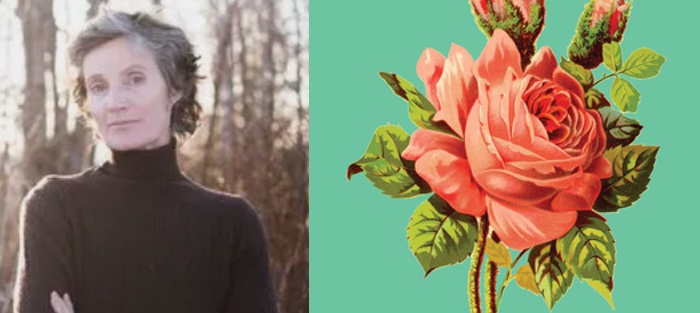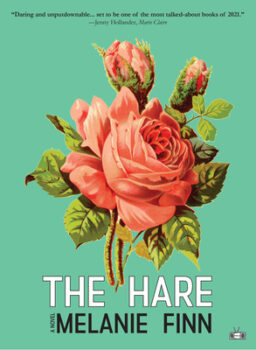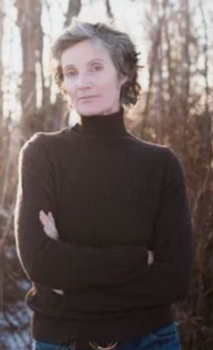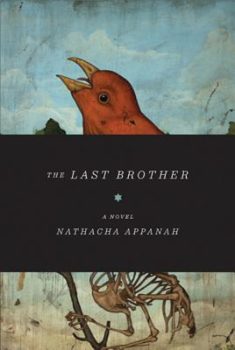I was first introduced to the work of Melanie Finn when I read and reviewed her second novel, The Gloaming. I was struck by her ability to pen a true literary page-turner and became an immediate fan. So when publisher Two Dollar Radio announced Finn’s latest, The Hare, I knew I wanted to speak to the author about her techniques and approach to storytelling.
In The Hare, a young art student, Rosie, is swept into a romantic relationship by the Waspy Bennett, an older man, who relocates Rosie from New York City to Connecticut’s Gold Coast and charms her with his worldly knowledge. Soon, Rosie drops out of college and is pregnant with Bennett’s child, and after baby Miranda’s birth, Bennett abruptly moves the family to rural Vermont, where Rosie and Miranda are left stranded for weeks on end while Bennett theoretically teaches at a local college, though Rosie suspects the job is a cover for more sinister actions. As Rosie, a survivor of childhood abuse, adjusts to her new life, Bennett turns increasingly deceptive. Their relationship grows increasingly distant, and as Finn barrels her characters toward confrontation, she beautifully captures the mixture of hope, heartbreak, and fury that runs through Rosie. Throughout, the novel questions the idea of obligation and ponders society’s patriarchal structure.
Melanie Finn is the author of the novels Away From You, The Gloaming, The Underneath, and The Hare. The Gloaming was a New York Times Notable Book of 2016 and a finalist for both the Vermont Book Award and The Guardian’s “Not the Booker” Prize. Finn’s screenwriting credits include the wildlife documentaries Crimson Wing: Mystery of the Flamingos, from DisneyNature, and Turtle: The Incredible Journey. She is the co-founder and director of the Tanzanian-based charity Natron Healthcare, and she lives with her family in the Northeast Kingdom of Vermont.
Interview:
Benjamin Woodard: When your protagonist Rosie is introduced in the early 1980s, she is an art student wooed by Bennett, and by the end of the novel, in 2019, she works as an accountant, yet there is a small painting that, without ruining anything, appears a couple of times in her story. Though it isn’t exact, I read the painting to be based on Jan van Eyck’s Arnolfini Wedding portrait? Is that correct?
Melanie Finn: Yes.
Why did you choose this painting?
I studied art at NYU in addition to journalism. For me, it was a way of understanding history. That part is reflected in Rosie: this young girl comes from not understanding the world at all. Her way of interpreting comes through paintings and their histories. I knew that somehow a painting was going to play a role in her destiny. I’ve always loved the Arnolfini painting. There’s a claustrophobia in it: the husband, his young bride. There’s this narrow space, and she’s laced in, and he looks kind of bored, like he’s just doing this for her. And I thought about the role of women and the expectation of a lack of freedom that to me came through that painting. What is a painting? It’s for you to get a feeling from, to draw something personal from. As Bennett points out, what’s the point of reading the blurb that tells you what you’re supposed to feel about a painting?
Right around the time of van Eyck, artists started moving away from religious scenes and painted more household scenes. It was almost like reality TV. All of a sudden, there was this idea of looking at how “real” people lived. A hundred years later, you see the focus turn to the servants in the background. It interested me to juxtapose the expectations placed by society versus our reality, and how both of those are hard.
Paintings like this tell a story, and there’s a launchpad to where you could take that story as a person. With my books, there’s a certain point where people say, “I didn’t like this,” or, “Why did you do this?” And it’s like, “It’s my book!” You can do whatever you want with the characters when the book is done. You’ve done your job if you’ve created characters that feel so authentic that people get upset when they don’t do what they want. That’s the beauty of the Arnolfini painting. You feel the reality of those people so much that you can take their story out of the image.
Within your version of the painting is a maid holding a dead hare. We also have a frozen hare Rosie discovers late in the book. What made you place this maid with the hare into the painting? Was it meant as a thread for the novel?
I remember another painting of the inside of a house from around the time of the van Eyck painting. You see through the kitchen and there’s a slab of light, and in my mind there’s a maid there carrying a bucket of milk. I’ve searched high and low and cannot find it. It’s entirely possible that I constructed it in my memory. But this is one of those strange things about writing. The painting in the book came to me as these two paintings put together.
Then there’s the hare. There’s sometimes a magic element in writing, a weird thing where, as you progress along, you realize you’ve sown these seed that you can use later on. And like Rosie, I did discover a hare under our neighbor’s porch that had been shot and mummified by the conditions. It was a beautiful thing, and I can’t explain why that image was so powerful for me. The idea of being in flight and being pursued, and this poor animal dying exhausted under this porch for nothing. I think something like that echoes how Rosie was pursued for no reason. There was no reason for this kind of meanness.
You’ve worked in the past as a screenwriter. Does your idea of structure, of sowing the seeds, as you say, play into that history?
Absolutely. Journalist and author Tim Lott has been writing a new book, and in it he talks about the three-act structure, the five-act structure, and the hero’s journey as these fundamental ways that we put stories together. If you don’t put stories together in these ways, they don’t work. Part of it is that we’ve always heard stories in a certain way with a certain cadence. The story is essentially about a conflict. If you don’t have a conflict you don’t have a story. I’m talking about Western storytelling here.
If you look at “The Three Little Pigs,” it’s a perfect three act structure. You introduce the characters in the first act. You have three very different individuals. One is profligate. One is a little more thoughtful. One saves his money to build a really nice house. That’s the first act. In the second act, you have the wolf, right? You have all this conflict. And then you have the resolution, which is that the pigs get together and fight this monster in the third pig’s house.
So even from an early age we’re taught this idea of introduction, conflict, and resolution. When people understand that, all of a sudden, they see it everywhere. It’s like a Magic Eye picture: suddenly there’s the path. Character and plot are totally dependent on each other. If you have an inauthentic character or plot that doesn’t work, everything falls apart. Being creative, like those moments of embellishment in poetry, is great, but the basis of it has to be structurally sound.
Sure. Even the shortest Lydia Davis stories contain something that is technically a conflict, even if it’s only a few sentences long.
Writing is a skill. It’s not a gift. People say, “I’m not a writer,” never having tried because they haven’t felt moved to write 15 pages in a journal every day, which is not writing either. Then when people do start to write and they have a block they think, “Oh well, the muse left me.” But all of this is structure. This is structure and craft, and unless you’re prepared to go in and understand how things are put together and learn how to put them together, you’re never going to get past 1,000 words. This is my approach: looking at everything structurally, deconstructing the mythology around what it means to be a writer. Do you think it’s the same in poetry, that essentially poems are about conflict and then there’s a resolution, an emotion, or an event, and then there’s a resolution at the end?
I’ve been talking about that idea with my students. Where is the turn in the poem? Where does it become something more than, say, watching ponies in a field? So it’s that, but it’s also driving them toward the emotion that they’re sometimes too afraid to get to because it’s vulnerable.
Nadine Gordimer wrote a wonderful essay where she talks about this strange intersection where writers work, which is between the profoundly personal and the exterior world. How you’re in this dialectic state that’s both an oppositional pole and an integration. I think we’re constantly exploring that, and then people ask, “So what part of the story was about you?” My last book, The Underneath, begins with the main character following her husband into the basement. She’s holding a hammer, and she’s so overcome with rage that she thinks about smashing his head in, and my brother-in-law accosted me and said, “I am outraged by this book. I know that you’re writing about your marriage.” He said he even recognized the house. I said, “Our house doesn’t have a basement.”
(Laughing) One great thing about being a writer, though, is that you can always look back at your work and see it as a hidden journal about who you were throughout your life. You can remember things that inspired that moment in the story, even if you yourself don’t appear.
It’s this amazing opportunity to live all these other lives. You only have your own life, but as a writer you get to inhabit other selves and go in all these other directions. I always used to wonder about people like Iris Murdoch, who lived in a house with the same man forever, rode her bicycle to Oxford, where she taught, and then rode her bicycle back home. That is all she ever did in her exterior life. But she wrote these incredibly complex books about other characters. And that’s what it’s all about: exploring these lives you’ll never get to have. And I think it is honestly why writers feel compelled to write. You’re almost bored with yourself, and like an actor, you want to inhabit some other self and lead some other life. It’s a kind of greediness.
This leads me to ask about one element in The Hare. Rosie spends most of the novel moving around New England, and as a New Englander, I was fascinated by the way you were able to capture the subtle regionalisms between, say, Connecticut and Vermont.
Part of that has to do with being a journalist. One is trained to create a setting very clearly for readers in a concise way. Really that’s all it is, and then the elaboration of the writing coating that. But it’s paying attention.
I once saw Werner Herzog, who is kind of a crazy hero of mine, speak at Dartmouth College. He had been invited by the film school. He was asked, “What advice would you give to a young film student?” Werner said, “This is all crap. You can learn all the technical stuff about filmmaking in three weeks. For the rest you have to go out and explore and have adventures. You need to get out of your car and walk.” And, of course, there was this silence in the audience. All these people were forking over $100,000 to learn at this four-year school of filmmaking, and there’s Werner basically throwing a grenade into the room. But it’s true. Getting out of your car and observing people, smells, the way things look, is a key part of being a writer. If you’re not prepared to observe on an intricate level how people live their lives and how the world unfolds, you’ll never be a writer. Close observations only come from long journeys.
I’m curious if, when the world gets “back to normal,” people will see things differently. If I look out my window now, there are so many people walking and seeing the world.
I think it’s always the path of least resistance. Here, when everything shut down, it was wonderful to go outside with my kids and pass all our neighbors out walking. It was wonderful to see the road being used for pedestrian traffic. A car would come and everyone would go, “There’s a car!”
And now with hybrids, you wouldn’t even hear it.
That’s what it’s like here in Vermont. You have either a hybrid or these stinking diesel trucks. In terms of understanding the community, teaching at the local high school here was enormously immersive for me, in terms of learning where these kids were coming from. What they said. What they felt about the world. I definitely used that classroom to listen to their stories.
Still, in The Hare I fear of the work being seen as affectation in some ways. I am middle class, and while I did have momentary struggles with money in my life, I don’t know what it is like to be systematically poor. Somebody recently criticized the character of Rosie, saying she had options to leave Bennett, and I was like, really? What options did she have? That’s the difference between being rich and being poor. Money buys you options. I remember being in a bar years ago, next to a drunk guy crying into his beer because his woman left him. He said, “Never give an ultimatum to a woman with a lot of options,” which is a great line, but I think of it in terms of Rosie. She doesn’t have options. She has ultimatums. What I see here in people around me is that they are facing ultimatums every day. Do you buy food or medicine? Do you buy your kid warm boots or a warm jacket? We don’t often hear from that segment of the population. They don’t have a voice. That troubles me, so even when I write about that, I wonder if it is an appropriation.
It’s interesting that you say this, because the past few years have seen a reckoning of sorts when it comes to dismantling and challenging patriarchal power in America. Despite much of the novel taking place in the 1980s and ’90s, it feels timely to these actions, certainly, yet for a good chunk of her story, Rosie finds herself without many options. She’s young and has a child with Bennett, and he moves her from Connecticut to Vermont. She is frequently suspicious of his intentions, yet for years she does little to escape.
In the early 1980s, a woman legally couldn’t be raped by her husband. That’s where this book starts. It seemed so bizarre, but a woman’s body did belong to her husband. I remember when they finally passed a federal law, there were people who opposed it. I was a young woman. What kind of message did that send to me? Also, I was sexually abused as a child. With Rosie, she’s coming into all of this damaged, being abused as a child, and she’s not able to see how the damage is affecting her. Not having money traps you, and being damaged traps you in another way.
I certainly look back at what I thought were my own options and I realize it was all reaction to that founding event in my childhood. This series of bad choices that I made were always tethered to that childhood event. I question the idea of free will in this book as something that is systemic rather than philosophical. If you examine your own life in relation to the nurture you had, how to you see it play out? In a way, I couldn’t write this book until I passed menopause because it closed in on a femininity and sexuality that came as a package deal. Being able to remove myself from that and look back was powerful.
Let’s finish with this. Nearly every character in The Hare hides a secret or two, and these secrets are only sometimes revealed to other characters. How do you decide what to reveal to other characters and when?
That’s one of the hardest things, certainly with the Bennett character. I had to figure out at what point does the reader figure out this guy is a dickhead versus when Rosie discovers it, and in that space between, how to keep us rooting for Rosie. We have a tendency to say, “How couldn’t you see he was a dickhead and leave?” Statistically, it takes a woman seven times to leave an abusive relationship. So there’s this suspending moment between when you know the character suspects something to when she finally decides she’s done. That was a difficult stretch for me as a writer.
The other part was getting a handle on Bennett himself, because he obfuscates. For a long time, he was even obscure to me. He’s kind of a Trumpian figure, in that he presents as a certain way. He makes grand promises, and you want to believe. But at what point do you reveal that person for who they are? Bennett remains quite obscure for the whole book. We see glimpses of him, but I think he’s also hidden from himself. He has worked hard to partition his life, as pathological liars are known to do. I definitely had to make him likable and attractive at the beginning and gradually peel that away.








